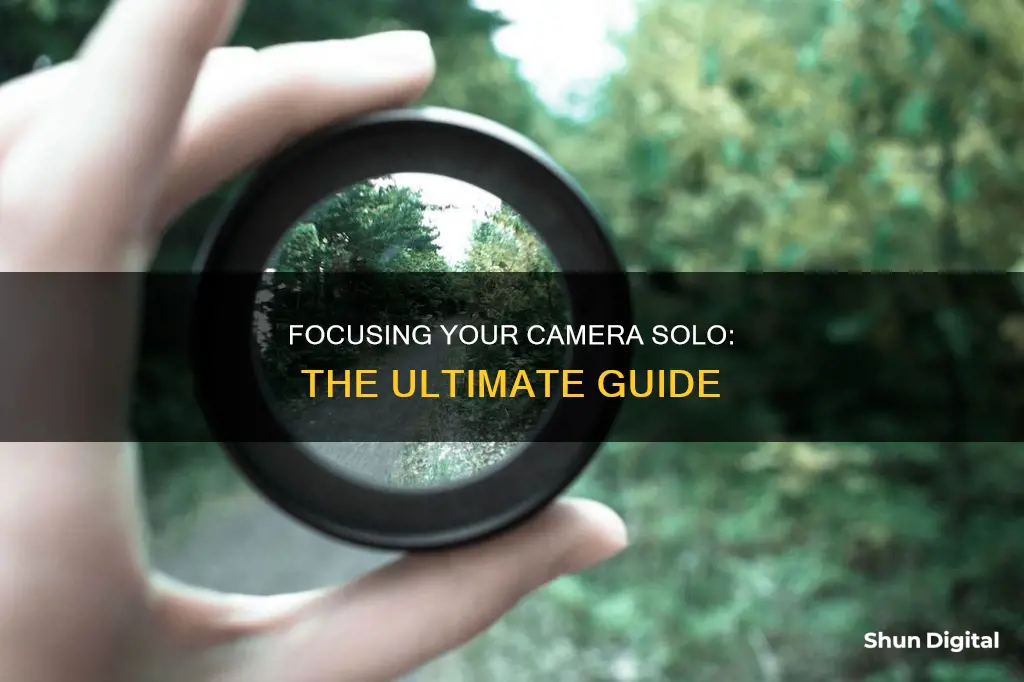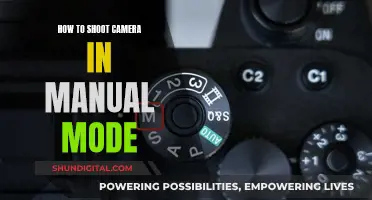
Focusing a camera solo can be a challenging task, but with the right techniques and practice, it is achievable. Whether you're a beginner or an experienced filmmaker, understanding how to maintain clear and crisp focus is essential for capturing captivating visuals. While traditional film sets employ focus pullers, solo filmmakers often navigate this task without specialised equipment. From utilising fixed focus for stationary shots to mastering manual focus adjustments, there are numerous strategies to ensure your subject remains in sharp focus. Additionally, advancements in autofocus technology have provided solo filmmakers with new tools to capture moments as they happen, although it may not always be reliable or suitable for every scenario.
| Characteristics | Values |
|---|---|
| Set focus | Maintain the same distance from your subject |
| Hold camera | Hold with one hand and manually focus with the other |
| Aperture | Shoot at a higher aperture |
| Autofocus | Use the camera's autofocus feature |
| Focus ring | Adjust the focus ring |
| Focus points | Set two focus points and smoothly move between them |
| External monitor | Use an external monitor to help with manual focusing |
What You'll Learn

Use a fixed focus for stationary subjects
Focusing on stationary subjects is relatively straightforward. If you're shooting an interview or a portrait, for example, you can use a fixed focus. To achieve this, move the focus ring on your lens until the subject comes into focus.
This is a simple technique, but it's important to ensure that both your camera and your subject are stationary. If your subject starts to move, you'll need to adjust your focus accordingly.
Another option for stationary subjects is to use autofocus. This technology was first introduced by Leica in 1976 for photography cameras and later optimised for video by Canon, Sony and Panasonic. While autofocus can be incredibly helpful for capturing moments as they happen, it may sometimes focus on the wrong part of a scene.
If you're filming alone, you might not have the luxury of a wireless follow focus or a professional focus puller. In this case, a fixed focus can be a reliable solution for ensuring your subject remains sharp and clear.
Easy Fix: Recovering Unsaved Camera Raw Edits
You may want to see also

Move in sync with your subject
Moving in sync with your subject is a great way to keep your shot in focus while filming a moving subject. This technique requires you to set the distance you want to maintain between you and your subject, then set the focus, and then get the subject to move towards you or away from you. As they move, you must maintain the same distance by moving backward or forward with them, keeping the same distance at all times.
This technique can take some practice as it is very easy to go too fast or too slow and lose the focus point. However, if you can keep the same distance while moving after setting the focus, your image will stay pin-sharp.
It is important to note that you will need to be able to adjust your camera settings to compensate for any loss of light that may occur as a result of using this technique. Additionally, this technique may be more challenging to execute if you are also operating additional gear simultaneously.
- Practice makes perfect: The more you practice this technique, the better you will become at maintaining the same distance from your subject while moving.
- Start with a simple setup: Begin with a basic setup and gradually add more elements to challenge yourself. For example, you can start by filming a subject walking towards or away from you in a straight line, and then try filming a subject moving in a more complex pattern.
- Use a camera rig: Invest in a rig that will keep your shots steady, such as a glidecam or a gimbal stabilizer. This will help you achieve smoother footage and make it easier to maintain focus.
- Communicate with your subject: Let your subject know that they should maintain a certain distance from the camera while moving around. This will help ensure that they stay within the frame and don't move too quickly or slowly.
- Pay attention to your surroundings: Be mindful of any obstacles or hazards that may interfere with your shot. This will help you avoid accidentally bumping into something or losing focus as you move with your subject.
The Polaroid SX-70 Land Camera: A 70s Innovation
You may want to see also

Set a focus point and bring your subject into it
Setting a focus point and bringing your subject into it is a great technique for keeping your subject in focus while filming solo. Here are some tips to help you master this technique:
Finding Your Focus Point
Start by identifying a point in your frame that you know your subject will pass through. This could be a spot on the ground or any other reference point that will help you set your focus. If you're struggling to find a suitable focus point, consider using the "focus and recompose" technique. This involves first focusing on your subject's eyes, for example, and then recomposing your shot to place your subject to the side, creating a more interesting composition.
Setting Your Focus
Once you've identified your focus point, it's time to set your focus. If you're using a manual focus, turn the focus ring on your lens until your chosen focus point comes into focus. If you're using autofocus, you can use your camera's autofocus lock feature to lock the focus on your chosen point.
Bringing Your Subject Into Focus
Now that your focus is set, it's time to bring your subject into that focus point. This can be done by either moving your camera or having your subject move. If you choose to move your camera, be sure to maintain the same distance from your subject throughout the shot. This technique is commonly used by vloggers who point the camera at their face, set the focus, and then move the camera around as long as the length of their arm remains the same.
Practise Makes Perfect
Remember that this technique requires precision and timing. It may take a few tries to get it right, so don't be discouraged if you don't nail it on the first attempt. With practice, you'll develop a feel for how to adjust your focus ring and how much you can move your camera or subject without losing focus.
Alternative Techniques
While setting a focus point and bringing your subject into it is a valuable skill to have, there are also other techniques you can use to keep your subject in focus when filming solo. These include locking the focus and moving with your subject at the same distance, using a high f-stop or high aperture setting, and utilising your camera's autofocus feature. Each technique has its advantages and disadvantages, so it's worth experimenting to find the ones that work best for your specific needs.
Camera Batteries: Carry-on Essentials for Air Travel
You may want to see also

Shoot with a high f-stop
Shooting with a high f-stop is a great way to ensure your subject stays in focus, especially when filming solo. The f-stop (or f-number) measures the aperture of your camera lens, or how much light is let in. A higher f-stop lets in less light and sharpens both the subject and the background, increasing the depth of field. This is ideal for landscape and architecture photography, where you want to keep everything in focus and show off the details.
When shooting with a high f-stop, it's important to consider the trade-off between depth of field and sharpness. While a higher f-stop increases the depth of field, it can also lead to a loss of sharpness due to lens diffraction. This is particularly noticeable in lenses with a wide angle or when printing at large sizes. To mitigate this, you can start with a lower f-number and gradually increase it until you find the right balance between depth of field and sharpness.
Shooting with a high f-stop is also useful when you want to include a clear focus on the atmosphere or background, such as when photographing a portrait of a bride and groom in front of a church. It is also ideal for creating a starburst effect, as a small aperture is needed for this technique. Additionally, a high f-stop is beneficial for astrophotography, as it helps to achieve a nice, solid focus on the stars.
When deciding whether to shoot with a high f-stop, consider the specific situation and the look you are trying to achieve. While a higher f-stop can provide the benefit of increased depth of field, a lower f-stop can also create powerful images by keeping the subject in focus while blurring the background. Ultimately, experimenting with different f-stop settings will help you create interesting and varied images.
Are Toledo's Camera-Issued Speeding Tickets Legally Valid?
You may want to see also

Use autofocus
Autofocus is a useful tool for solo filmmakers and photographers. It can be used to achieve a sharp focus on your subject without the need for a professional focus puller. Here are some tips for using autofocus:
Understanding Autofocus
Firstly, it is important to understand how autofocus works. A camera's autofocus system adjusts the camera lens to focus on a subject, ensuring a sharp image. Autofocus can work through passive AF, which uses contrast sensors within the camera, or active AF, which emits a signal to estimate the distance to the subject. Passive AF can be further divided into contrast detection and phase detection methods, both of which rely on contrast to achieve accurate autofocus.
Steps to Use Autofocus
- Set Lens to AF Mode: Find the AF-MF option on your camera lens, usually on the lower left-hand side. Ensure it is set to AF mode.
- Switch to Live View Mode: Once the lens is in AF mode, switch your camera to live view mode. This mode allows you to zoom in on your subject and move the focus point around the screen.
- Zoom in on the Subject: Use the multi-controller stick to move the focus point to the desired area of the image.
- Hold the AF-ON Button: Once you have selected the focus point, hold down the AF-ON button until the camera auto-focuses. The camera will calculate and set the focus, as well as the white balance and ISO if needed.
Advantages of Autofocus
Autofocus is particularly useful when filming or photographing moving subjects. It can track and adjust the focus as the subject moves, ensuring they remain sharp and in focus. Additionally, autofocus can be beneficial in low-light conditions or when there is insufficient contrast in the scene.
Limitations of Autofocus
While autofocus is a powerful tool, it has some limitations. One issue is "focus hunting," where the camera struggles to find the correct focus and continuously adjusts back and forth. Autofocus may also focus on the wrong part of a scene, which can be problematic in certain types of filmmaking or photography where specific elements need to be in focus to convey the desired story or message.
Extending SpyPoint Camera Battery Life: How Long Should It Last?
You may want to see also
Frequently asked questions
If you are shooting with a moving subject, you can try to maintain the same distance from your subject and use one hand to hold the camera and the other to manually focus. Alternatively, you can shoot at a higher aperture or use your camera's autofocus feature.
You can use a fixed focus by adjusting the focus ring on your lens until the subject is in focus. Alternatively, you can set a focus point and then have your subject move in and out of that point, or you can film with a high F-stop so that the foreground and background are both in focus.
You can use an autofocus feature if your camera has one. However, this may not always be accurate and may focus on the wrong part of a scene. You can also try to set two focus points and smoothly move between them.







